Out of all the constellations, only a handful can boast a distinct and recognizable pattern. Take Orion, for example, which resembles an hourglass or a human figure. In the case of the Swan constellation, a cross stands out, while the Big Dipper takes the shape of a dipper. These distinctive formations make it easy to remember and locate the constellations in the night sky. One such uncommon and expressive constellation is Cassiopeia. Let’s explore the appearance of the Cassiopeia constellation in the sky, how to locate it, and the significance of its brightest stars.
Appearance of the Cassiopeia Constellation
The Cassiopeia constellation is characterized by its compact shape, primarily formed by five prominent stars. Its configuration resembles either an inverted letter M or the Latin letter W. Observers often recognize this constellation in the night sky and remark, “Oh, I know this constellation! I just don’t know its name…” The simplicity and distinctiveness of the Cassiopeia drawing make it instantly recognizable.
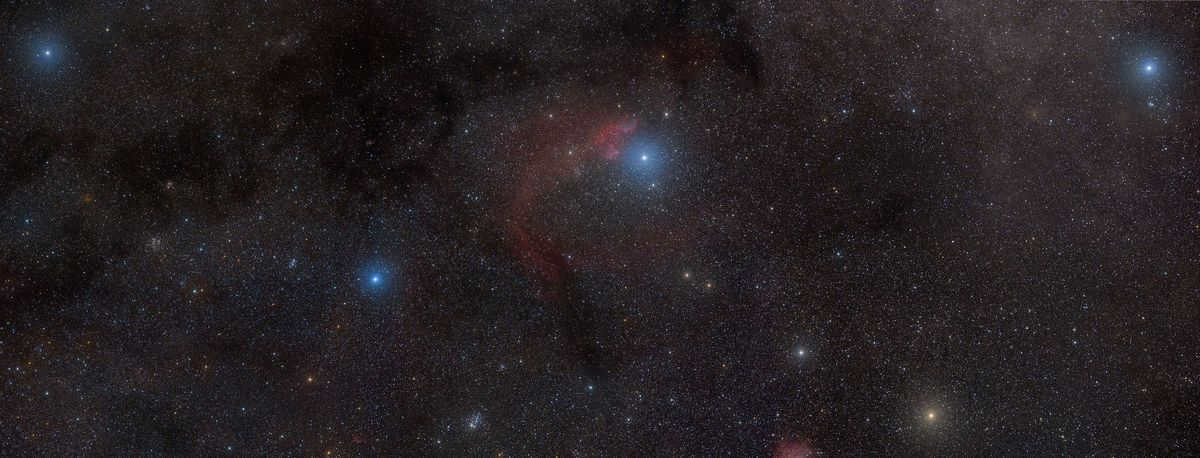
The prominent star formation known as the “double-ve” (W) represents the primary configuration of the Cassiopeia constellation. Feel free to click on the image to view a larger version. Photo credit: DeepSkyColors
It is important to note that the letter W (pronounced as “double-weh” or “double-u”) does not encompass the entirety of the constellation. No, it merely represents the most recognizable and attention-grabbing pattern within Cassiopeia. The actual constellation spans a much larger area than the W shape. These striking star formations are referred to as asterisms.
Tips on locating the Cassiopeia constellation.
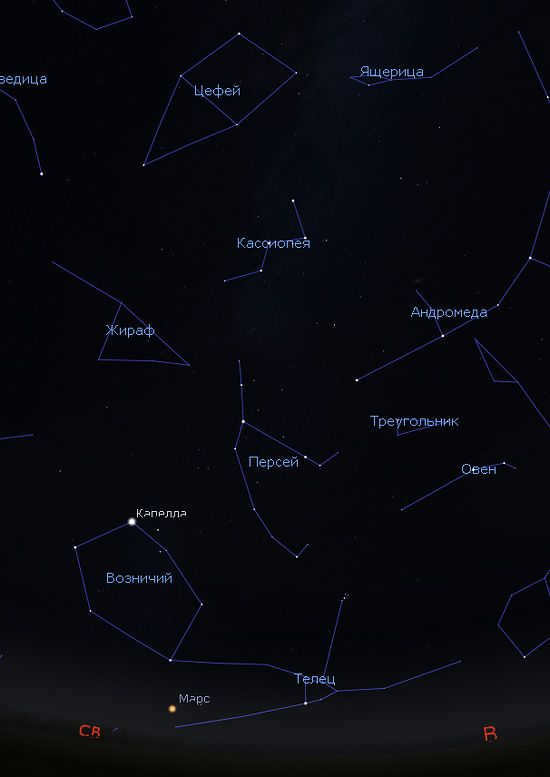
The constellation Cassiopeia can be found at a high position above the eastern horizon during the autumn season. In the winter sky, Cassiopeia reaches an even higher point, almost reaching its zenith. This information is illustrated in the figure from Stellarium.
Cassiopeia is classified as one of the seven non-sunsetting constellations visible in our sky. This means that it can be observed throughout the year. However, its location in the sky varies depending on the time and date. Similar to other constellations, Cassiopeia’s position in the sky changes as it orbits around Polaris, appearing high in the sky or near the horizon at different times of the day and year.
The ideal period to observe Cassiopeia is during the autumn season. During this time, the constellation can be seen at a high position above the eastern horizon in the evenings.
During the months of February and March, the constellation Cassiopeia can be seen sloping towards the western horizon. Interestingly, during this time, its pattern appears to be on its side. It is important to remember this when searching for Cassiopeia!
In May and June, Cassiopeia is at its lowest point above the horizon. During these months, the constellation can be briefly observed (although the nights are short and bright!) in the northern sky.
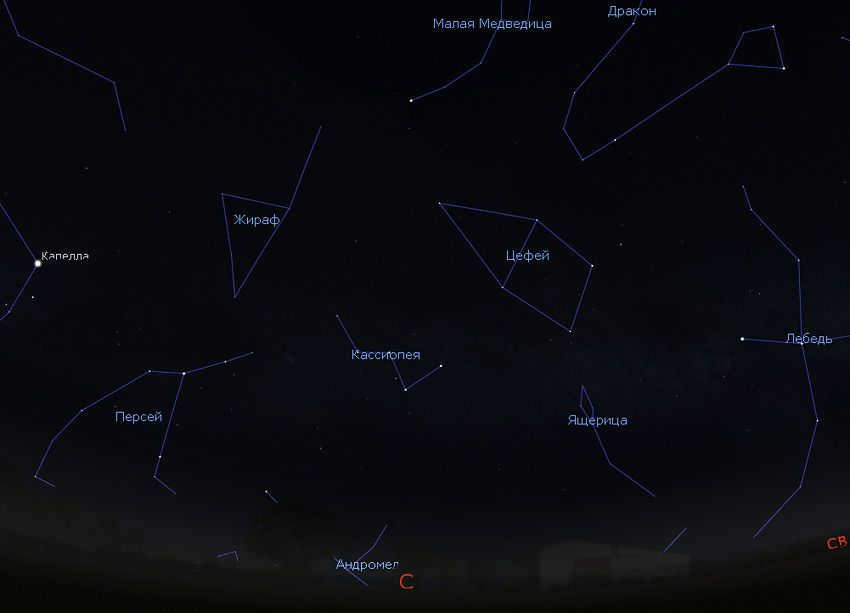
During the seasons of spring and summer, the constellation known as Cassiopeia can be observed at a low position above the horizon. Image: Stellarium
The legend of Cassiopeia
The legend of Cassiopeia, specifically the legend of Perseus and Andromeda, cannot be briefly omitted here. The reason for this will become apparent below.
This is a well-known tale. Once upon a time in a distant past, there was a ruler named King Cepheus, also known as Cepheus, who governed over Ethiopia. He possessed a stunning wife by the name of Cassiopeia and a daughter named Andromeda. One fateful day, Cassiopeia proclaimed that she was more beautiful than all the sea nymphs combined. (In today’s world, Cassiopeia would surely be a sensation on Instagram!)
As expected, the nymphs took offense and lodged a complaint with Poseidon, the deity of the ocean. In response, Poseidon released a formidable sea creature upon the kingdom of Ethiopia. This creature, known as a “ketos” in Greek (from which the Russian word “whale” is derived), whale, proceeded to wreak havoc upon the land with relentless frequency. Attempts to subdue or regulate its actions proved utterly futile.
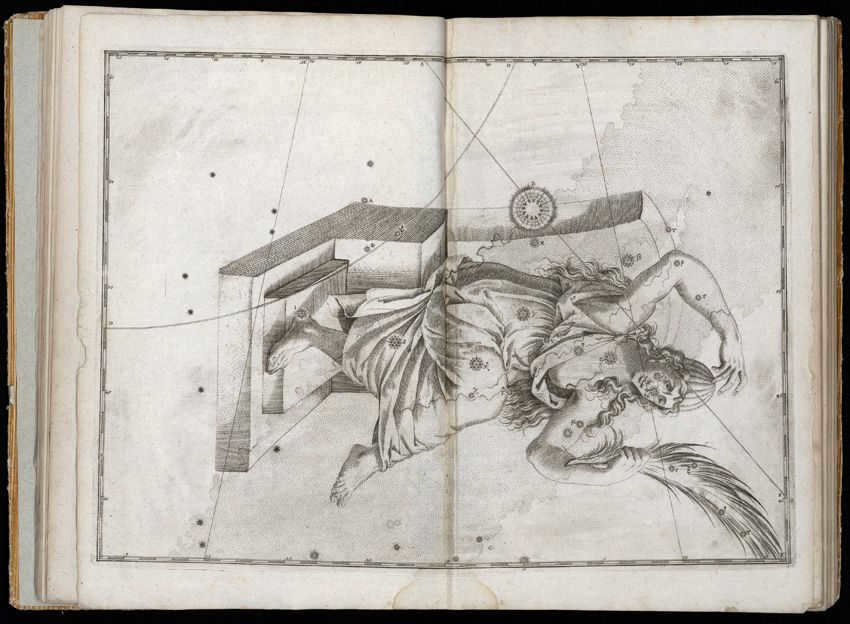
The constellation Cassiopeia is depicted in Johann Bayer’s atlas, Ulm, 1661. The source of this information can be found on skytonight.org.
Afterwards, Cepheus embarked on a desperate journey to Libya, seeking guidance from the oracle of Amon. The oracle suggested that the only way to save the country was to sacrifice the king’s daughter, Andromeda, to the monster. Although Cepheus initially had no intentions of sacrificing his daughter, news of the oracle’s advice spread among the people who forced him to give up Andromeda for torture.
Thankfully, the outcome turned out to be favorable. Andromeda was rescued by Perseus, who coincidentally found himself in Ethiopia. The winged steed Pegasus provided assistance. Perseus wed Andromeda, resulting in Cepheus and Cassiopeia becoming the progenitors of numerous illustrious heroes, including Hercules.
Take a moment to observe the night sky during the autumn evening. You will witness the presence of every single figure from this legendary tale!
The five stars in the constellation of Cassiopeia
The stellar inhabitants of Cassiopeia are a fascinating bunch. These celestial giants are massive and mighty, making our own humble Sun appear feeble in comparison!
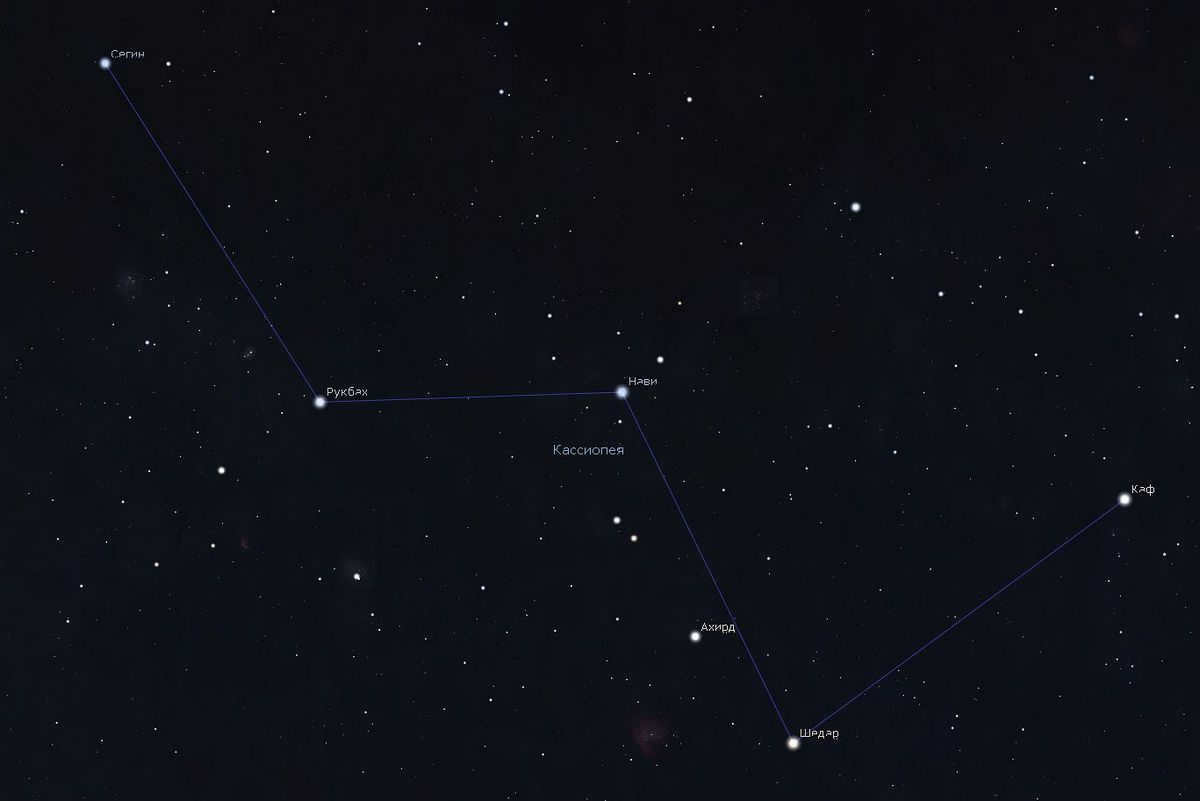
The brightest stars in the constellation of Cassiopeia are depicted in the image above. (Click to enlarge.) Figure: Stellarium
Navi: The Brightest Star in Cassiopeia
One of the most prominent stars in Cassiopeia is gamma star Cassiopeia (γ Cas), which is also known as Navi. Gamma Cassiopeia is positioned at the central point of the constellation’s W shape. It is classified as a hot and massive subgiant star, with a mass 20 times that of the sun and a diameter 14 times larger. In terms of brightness, Gamma Cassiopeia emits 55,000 times more light than our Sun! Just imagine the impact it would have on Earth if this colossal star were to replace our own!
Gamma Cassiopeia is an intriguing star that falls into the category of nova-like stars due to its variable nature. Its brightness can range from 1.6 m to 3 m. At times, it shines as the brightest star in the constellation, while at other times, it appears as the faintest among the five.
The Star Shedar
Shedar, also known as Alpha Cassiopeia (α Cas), is an orange giant star with a spectral class of KOIII. It is approximately 1200° cooler than the Sun, resulting in a lower light emission per unit area. However, due to its immense surface area, its total luminosity is 500 times greater than that of our own star. Alpha Cassiopeia has a diameter 37 times larger than the Sun and is 4-5 times more massive.
The star Kaf
The star Kaf, also known as beta Cassiopeia (β Cas), can be found at the right end of the W-shaped constellation Cassiopeia. It is considered to be the star that most closely resembles the Sun in terms of its characteristics. With a mass only twice that of the Sun and a diameter four times larger, Kaf shines 28 times brighter than our own star.
Delta Cepheus (δ Cas) or Rukbach is located near the gamma star of Cassiopeia. It is classified as a hot subgiant star. Although it does not possess the same gamma-ray characteristics as Cassiopeia, it still shines brightly. The mass of delta Cassiopeia is 3.3 times that of the Sun, and its radius is 4.12 times larger. The precision in measuring the radius to the second decimal place is due to the fact that delta Cepheus is a binary star. Not only that, it is an eclipsing binary or an eclipsing variable star! The companion star occasionally passes in front of the main component, causing small eclipses. By studying the light curve, scientists were able to accurately determine the size of the main star.
Epsilon Cassiopeia: The Left End of the W Asterism
Epsilon Cassiopeia, also known as Seguin, is a prominent star situated at the left end of the W asterism. It stands out not only due to its position but also because of its remarkable characteristics. As a hot giant star, Epsilon Cassiopeia is an astonishing 9.2 times more massive than the Sun, with a size six times larger and a brightness that is 2500 times more intense!
While most of the stars in the Cassiopeia constellation are located at considerable distances from us, ranging from 100 to 600 light years away, Beta Cassiopeia is relatively closer, being only 47 light years distant.
It is worth noting that the names of the stars in Cassiopeia are not widely recognized. If you were to inquire about the star Ruckbach to an amateur astronomer, chances are they would not be familiar with it. Instead, the stars in Cassiopeia are commonly referred to by their letter designations.
The arrangement of stars in the Cassiopeia constellation and its intersection with the Milky Way
As you observe the night sky, you’ll notice that the Milky Way traverses the Cassiopeia constellation. During a night devoid of moonlight, an enchanting sight awaits you as you witness the pale, slender strip of the Milky Way gracefully intersecting the W shape of Cassiopeia, diagonally from right to left.
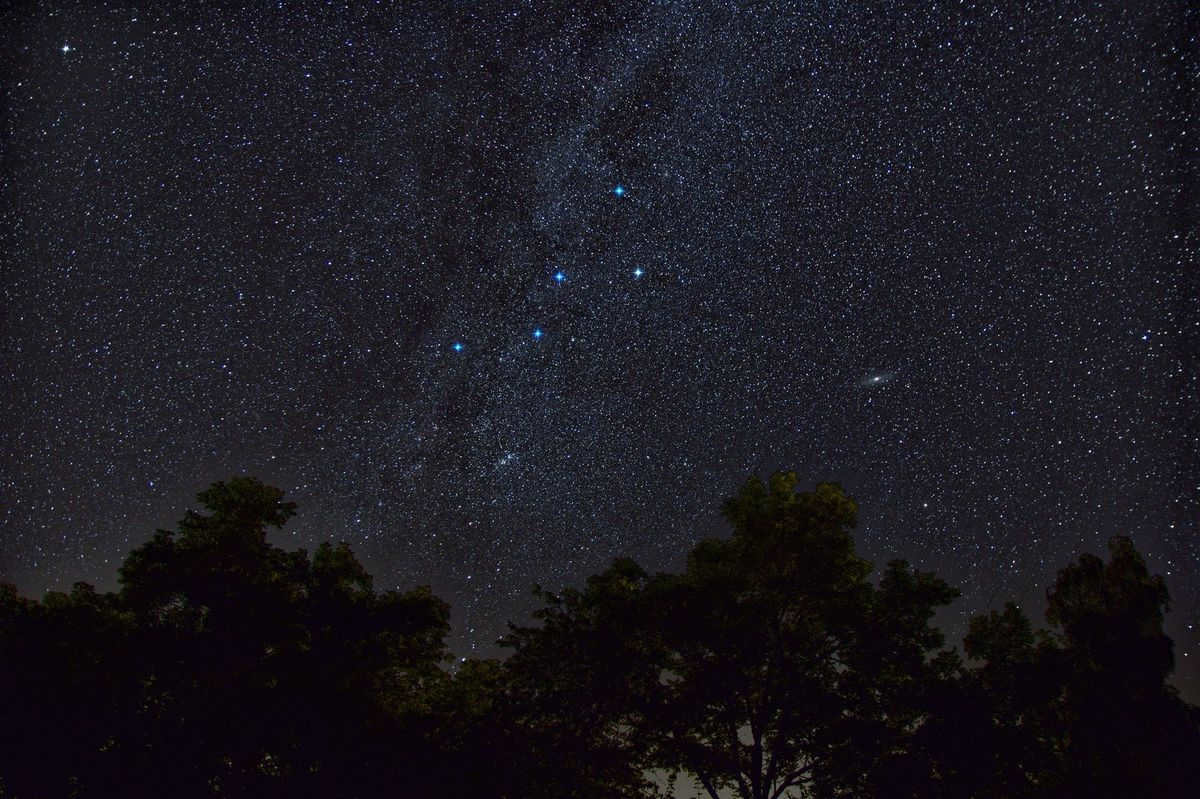
The Milky Way and Cassiopeia constellation follow a specific path in the sky. By clicking on the image, you can see it in a larger size. The photo was taken by Patrice Dardoize.
As many people are aware, the Milky Way represents the galactic plane visible in the night sky. Within this plane, there are various clusters of young stars, gas nebulae, and interstellar dust. Cassiopeia, in particular, is a rich area for deep space objects, with scattered star clusters being the most prominent. These clusters can be visually captivating when observed through binoculars or even a small telescope.
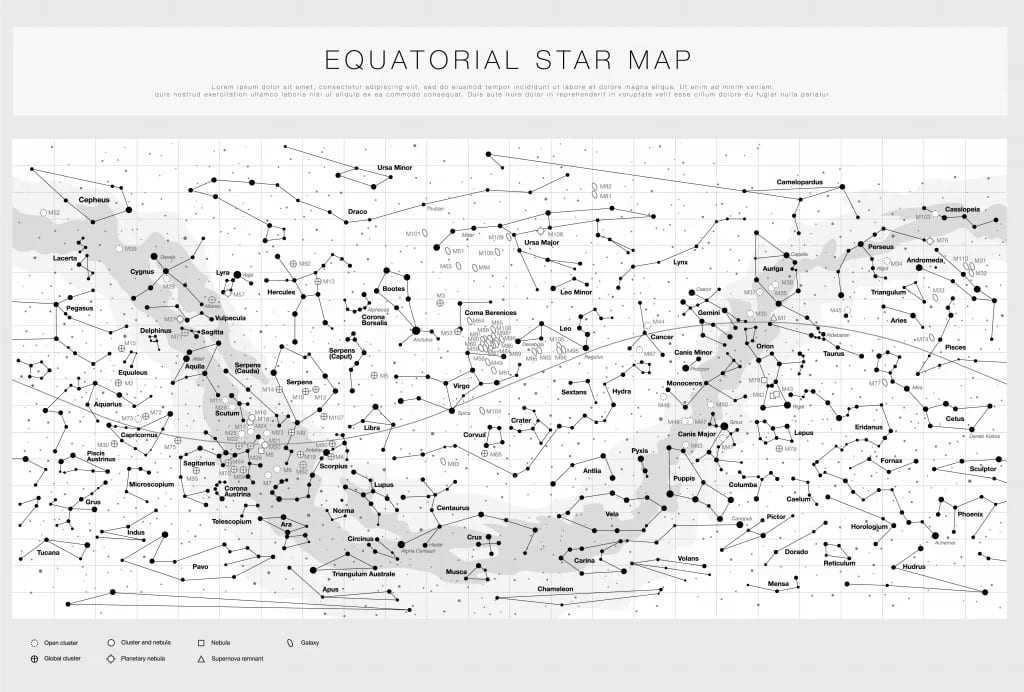
The response is certainly negative! The arrangement of stars in the celestial sphere has perpetually been in flux and will continue to be so.
We have made significant advancements in comprehending the appearance of our cosmos and identifying the various formations within it. Nevertheless, there is one element that has endured throughout the ages, connecting ancient and contemporary astronomy – the constellations!
Historically, people who gazed at the night sky relied on constellations to navigate and anticipate the changing seasons. These distinct arrangements (some of which are actually quite arbitrary) of stars served as the launching pad for humanity’s exploration of space. While Ptolemy initially documented 48 constellations, the International Astronomical Union (IAU) now acknowledges (or rather, has “partitioned the sky into”) 88 constellations.
Essentially, the prevailing notion of a constellation is that it represents an imaginary boundary in the sky and the arrangement of stars within that boundary. Any star, star cluster, nebula, or galaxy within that boundary is considered a part of that constellation. However, in our investigation of whether constellations evolve over time, we will focus solely on the star arrangement that constituted the original constellation.
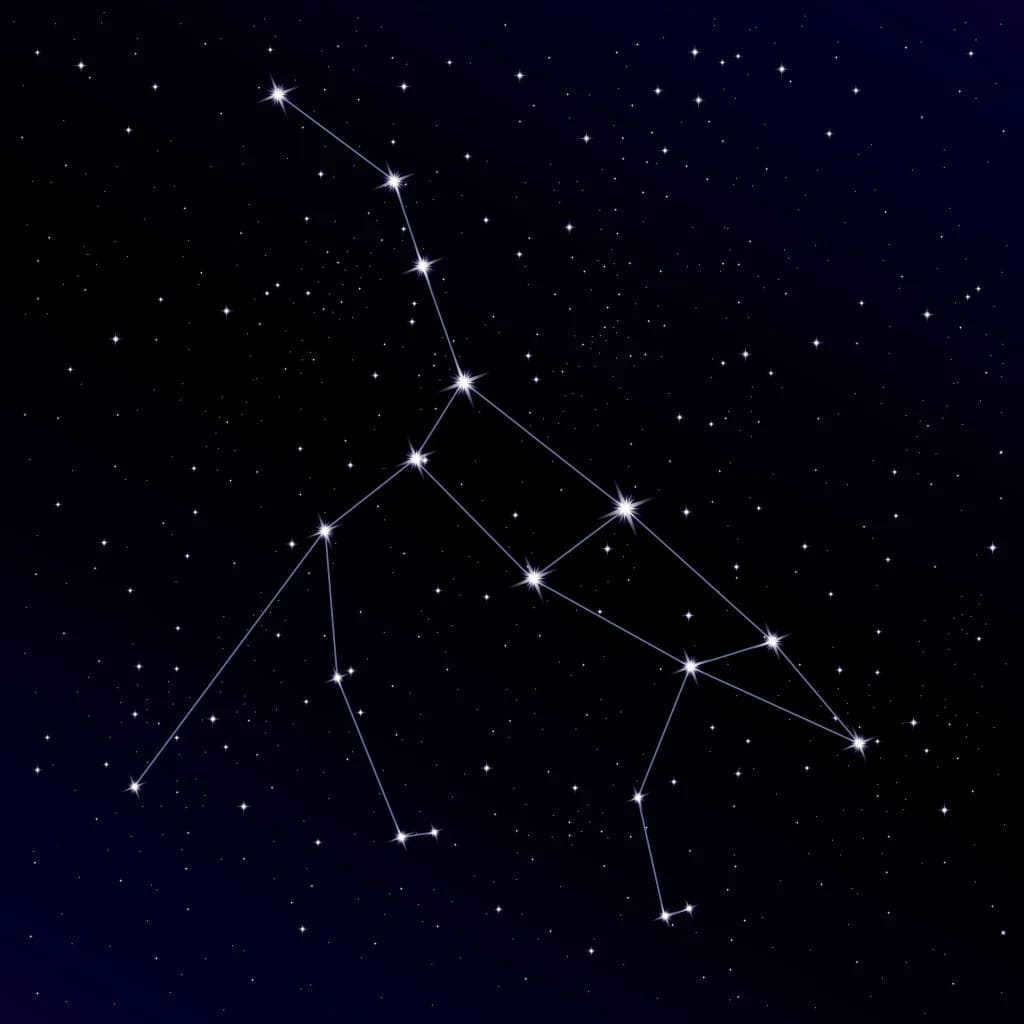
Now let’s address the question raised in this article: will constellations always maintain their current appearance? In all honesty, the answer is no. The arrangement of stars in the sky has always been subject to change and will continue to do so. We’re not even considering factors such as the Earth’s orbit around the Sun and the Earth’s axial precession. Therefore, the constellations and star patterns we observe today will not be identical to those of millions of years in the future or millions of years in the past.
To comprehend why this is the case, we must investigate whether there is any connection, such as gravitational forces, between the stars within a specific constellation. Additionally, we need a better understanding of how stars move through space and how we can observe these movements from Earth.
Constellations are not a “family”
It is important to understand that the stars comprising a specific constellation are situated at various distances from Earth. Consequently, the stars forming the pattern of a constellation are not gravitationally connected to each other. Their appearance of being linked is solely due to our limited two-dimensional perspective of the sky and the relative positions of the stars within it. Therefore, if we were observing the celestial sphere from a planet located in another stellar system, we would observe an entirely distinct configuration of stars in the sky.

Studying the movement of stars
Now that we have confirmed that the stars in a constellation are not interconnected, we can delve into understanding the individual motion of each star. It’s worth noting that the stars we observe in the night sky, much like our own sun, orbit around the center of our galaxy. Additionally, we observe different constellations throughout the year due to the Earth’s varying positions in its orbit around the Sun. However, these factors do not alter the arrangement of constellations or the position of stars in the sky.
The information we require is the “proper motion” of the stars. In the field of astronomy, the proper motion of a star is determined by observing the amount of shift the stars have undergone in relation to other distant stars. This shift can be measured in degrees, minutes, and seconds of angular displacement, with the assumption that the horizon spans 180 degrees from one end of the sky to the other. We can estimate degrees and minutes of angular displacement using our hands and fingers.
By extending our arm, we can observe that the little finger covers approximately 1 degree of the sky, while the ring finger, middle finger, and index finger combined cover around 5 degrees of the sky. If we spread the index finger and pinky apart, the separation equates to 15 degrees, and when we do the same with the thumb and pinky, it corresponds to 25 degrees.
The impact of proper motion and star lifespan
Let’s delve into the question of what the magnitude of stars’ proper motions entails. To put it simply, the magnitude is incredibly small. Take, for instance, Barnard’s star, which boasts the fastest proper motion in our celestial sphere. It would require a whopping 350 years for this star to traverse just 1 degree of the sky, equivalent to the width of a single finger. For most other stars, the timeframe to cover the same distance would be even longer. This is despite the fact that stars zoom through space at speeds of tens (and occasionally hundreds) of kilometers per second. Quite impressive, considering that the fastest car on Earth, the SSC Tuatara, reaches a speed of 0.148 kilometers per second. The reason why these astronomical movements don’t have any discernible impact on our night sky is due to the vast distances that separate Earth from the stars.
Aside from its own movement, there is also the scenario where a star might undergo an explosion and ultimately perish. Given that it requires a certain amount of time for the light emitted from such an explosion to reach us, it raises doubts about the actual existence of the stars we observe today. While the likelihood is low, considering that stars have lifespans that greatly exceed those of humans, there remains the potential for a massive star to detonate within the coming few centuries or millennia. Prominent contenders in this regard are Betelgeuse and Rigel, which happen to be stars located within the Orion constellation, also known as the Hunter.
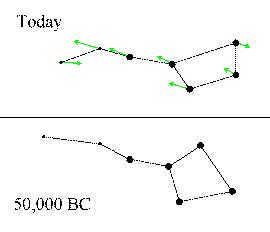
The arrangement of constellations in the night sky is not fixed and will gradually change over time. This process occurs at an incredibly slow pace, meaning that any noticeable alterations will not happen within an individual’s lifetime. In fact, the changes are so gradual that we are essentially observing the same constellations that ancient civilizations like the Romans and Egyptians did. It takes approximately 100,000 years for the constellations to transform beyond recognition.
Due to the varying proximity of stars, each star will shift at a different rate. This means that while we can continue using the current constellations for the next few thousand years, astronomers will likely need to develop entirely new constellations in the distant future!
Estimated reading time: 10 minutes
Share
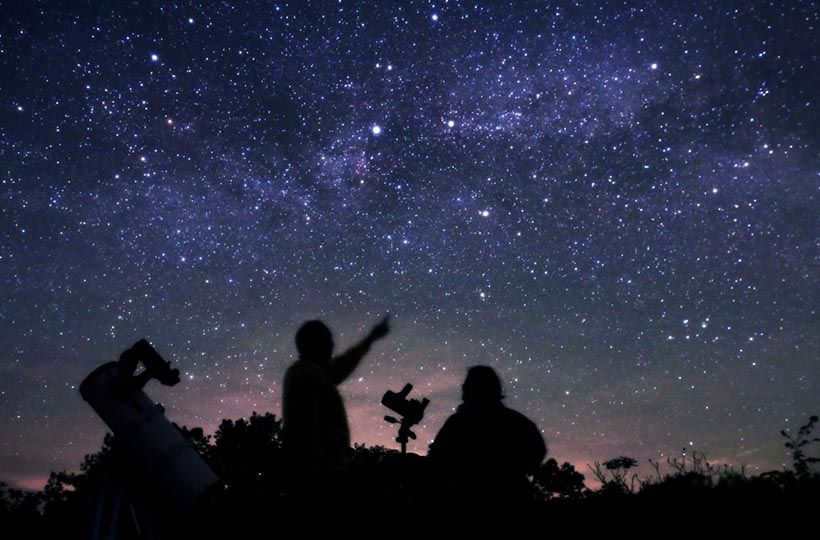
- Natal Astrology
- Relationship Astrology
- Self Development and Psychology
- Predictive Astrology
- Horoscopes and predictions
- Talismans
- Soul Formula
- Numerology
- Astrological Tarot
- World Astrology
- For beginners
- For professionals
- Astrologer Development
Read for at least 10 minutes
Which constellations can we see in the summer? The summer constellations are the ones that are most visible during this time of year. There are quite a few of them. Some of these constellations can also be seen in other seasons, but they are only high in the southern sky during the summer, and each one has its own unique characteristics.
How can we search for them? Summer provides a wonderful opportunity to observe the magnificent starry skies, particularly in remote areas far from city lights that obstruct the view. Despite the limited duration of darkness, there is ample time to locate and identify all the constellations, which fortunately are clustered together.
Key takeaways from this article:
Summertime Constellations
While in the winter, the stars appear like sparkling diamonds, in the summer they shine gently, creating a seemingly endless and profound sky. However, this does not bring about fear, but rather instills a sense of tranquility and joy. The stars in the summer sky gaze upon the Earth, as if numerous tender eyes revealing the depths of infinity to the soul and bringing about harmony with it.
Only a portion of the constellations visible in Russia can be seen, while the others never make an appearance and are located far to the south. One could say they are beneath our feet. The visible constellations are categorized as either seasonal or near-polar.
The constellations near the poles can be seen in the sky constantly, no matter the season, as they never dip below the horizon. These constellations include Cassiopeia, the Big Dipper, and the Little Dipper. On the other hand, seasonal constellations only become visible during specific times of the year, such as fall, spring, summer, or winter.
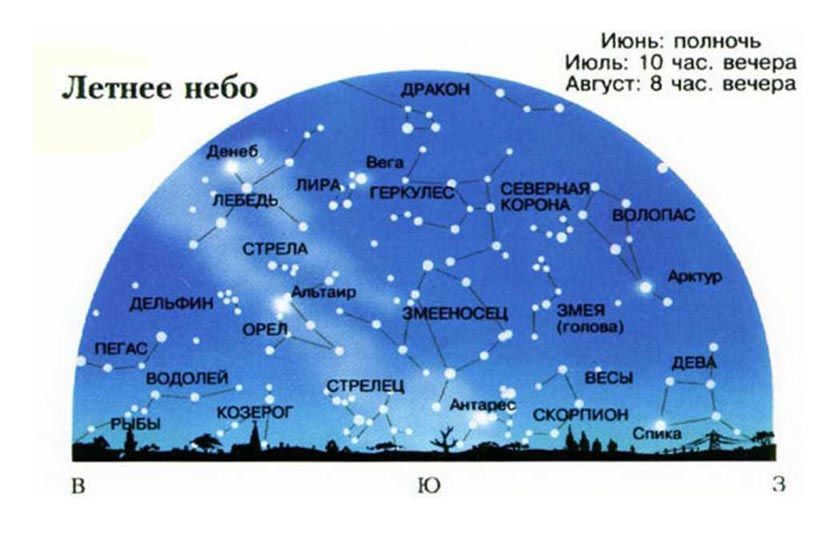
The constellations that can be observed in the summer sky are visible in June, July, and August when looking towards the southern side. During this time, they are at their highest point above the horizon, making it the most convenient time to observe them throughout the year.
All of these constellations can be seen on summer evenings in the southern part of the sky, ranging from the southwest to the southeast, typically appearing shortly after dusk. However, it’s important to note that the twilight period in Sochi occurs earlier compared to places like St. Petersburg, where the nights are brighter. Despite this difference, the general rule remains that evening is the time when stars become visible in the sky, even if it’s midnight.
In the summer months, you have the opportunity to witness incredible phenomena such as the Milky Way and shimmering silver clouds.
In the summer night sky, you can observe various constellations including Hercules and the Northern Crown, Serpent and the Serpent, Swan and the Eagle, Scorpio and Lyra, Shield and the Dolphin, Arrow and the Fox, Sagittarius and Capricorn. Lizard and Aquarius are sometimes included in this list. Additionally, if you look towards the south, you may catch a glimpse of Microscope and the Southern Corona.
During a July evening, you will find the Big Dipper positioned in the northwestern sky, with its tail pointing towards the left in a southerly direction, and its feet and partly its head facing downwards.
The winter constellations, which are currently hidden beneath the northern horizon, can’t be seen at this time. They are located deep within the sky, towards the direction indicated by the head of the Big Dipper. However, in the same region of the sky above the horizon, you can observe the constellations Perseus, Ascendant, and to the left of them, on the edge of the celestial dome, is the prominent star Gemini. Unfortunately, it is currently obscured by fog and clouds, making it impossible to see. Another constellation in the northeastern direction, at the same altitude as the Big Dipper and Polaris, is Cassiopeia. Just below Cassiopeia, you can find Andromeda.
When looking towards the south, you will notice the constellation Lyra. To the left of Lyra is the Swan constellation, and below it is the Eagle constellation.
Constellations in the Summer Months
During the summer months, the night sky offers a variety of different constellations to observe:
June
Capricorn
The Capricorn constellation, derived from the Greek word Boώτης meaning shepherd or plowman, is one of the largest constellations visible in the northern hemisphere. It was first identified by Ptolemy in the 2nd century. This constellation is home to the star Arcturus, which ranks as the second brightest star in the Kiel constellation and is only surpassed in brightness by Canopus and Sirius in the Great Dog constellation.
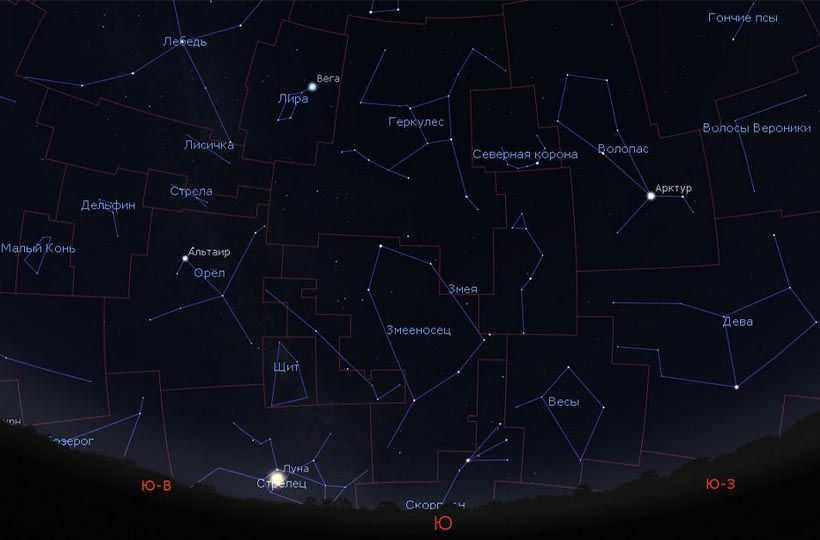
Circinus
This star pattern can be found in the southern part of the night sky. The name Circinus comes from Latin and means “a small circle”, which refers to a tool used for drawing circles. It was first observed and recorded by Nicolo Louis de Lacaille in the 18th century. Circinus fills the gap between the constellations Centaurus and the Southern Triangle. Some notable celestial objects found within this constellation include the X-ray source Circinus X-1, the Circinus galaxy, the planetary nebula NGC 5315, the open clusters NGC 5823, and the pulsar PSR B1509-58.
Libra
Situated in the southern region of the celestial sphere, the constellation Libra is part of the collection of astrological star clusters known as the zodiac. In astrology, there are a total of 12 zodiac constellations. Its Latin name, Libra, translates to “scales.” The depiction of Libra features a set of scales being held by the Maiden, who represents Astrea (Dike), the goddess of justice. It is worth noting that Libra is the only zodiac constellation that portrays an inanimate object rather than a living being. The constellation consists of Alpha and Beta, which form the balanced line of Libra, as well as Sigma and Gamma. Additionally, it is home to Methuselah (ND 14028Z), the oldest star in the known universe. No other stars in Libra exceed first magnitude.
Wolf
The group of stars known as Wolf, or Lupus in Latin, can be found in the southern hemisphere, nestled between the constellations of Scorpius and Centaurus. It was first identified by the ancient astronomer Ptolemy in the second century. While it has been recognized for centuries, there are no specific myths or legends surrounding this celestial formation. Notable features of the Wolf constellation include the presence of two globular clusters named NGC 5986 and NGC 5824, the remnants of a supernova known as SN 1006, and a nebula designated as IC 4406.
The Constellation Ursa Minor
Ursa Minor, also known as the Little Bear, is a summer constellation located in the northern part of the sky. It was discovered by the Greek astronomer Ptolemy in the 2nd century. This cluster of stars can be easily identified by its position at the celestial pole and its famous asterism. The star Polaris is found at the end of the handle of the dipper.
The Little Bear was included in Ptolemy’s list of constellations, but it was also mentioned by Thales of Miletus, one of the seven Greek sages who lived in 625-545 B.C. Another theory suggests that the Greeks discovered it, but the Phoenicians, who used the constellation for navigation, were the ones who found it. In Greece, it was initially called the Phoenician before being named the Little Bear (or the Tail of the Dog).
July
Bird of Paradise
Situated in the southern hemisphere, this constellation bears a resemblance to the bird of paradise. Its name is derived from the Greek word “apous,” which means “legless.” At a certain point in history, it was believed that exotic birds were incapable of walking. There are no myths or legends associated with the Bird of Paradise constellation. The constellation was first identified by the Dutch astronomer Petrus Plancius in the late 16th century, based on the observations of explorers like Frederick Hautman and Pieter Dirkszoon Keyser.

Sacrifice
Located in the southern part of the night sky, this constellation is commonly known as the “altar”. According to Latin mythology, it is believed to be the sacred place where Zeus and other Gods made a solemn oath before embarking on their battle against the Titans or Kronos. Another legend suggests that this altar once belonged to King Liacon of Arcadia. Comprising of 88 constellations, it was documented by Ptolemy in the 2nd century.
Northern Crown
The star cluster known as Corona Borealis, or “northern crown” in Latin, can be found in the northern part of the sky. While it may be small in size, it is easily recognizable. It consists of four stars that are brighter than magnitude 3.00. Ptolemy added it to the list of constellations in the 2nd century. Prior to the discovery of the Southern Corona, it was simply referred to as the Corona. Positioned between Hercules and Wolfsbane, it includes the star T of the Northern Crown and the variable R of the Northern Crown, but does not contain any notable deep space objects. All of the stars comprising the Northern Crown star cluster (Abell 2065) have a magnitude of less than 16.
Draco
The constellation Draco, known as the “dragon”, can be located in the northern part of the celestial sphere. It is one of the largest constellations. In ancient mythology, Draco is associated with the dragon Ladon, who guarded the gardens of Hesperides. This constellation, which was officially recognized by Ptolemy in the 2nd century, is of Greek origin and is circumpolar, meaning it never sets below the horizon for observers in the northern hemisphere. Some fascinating objects within Draco include the Spindle Galaxy (M102, NGC 5866), the Cat’s Eye Nebula (NGC 654Z), and the Tadpole Galaxy.
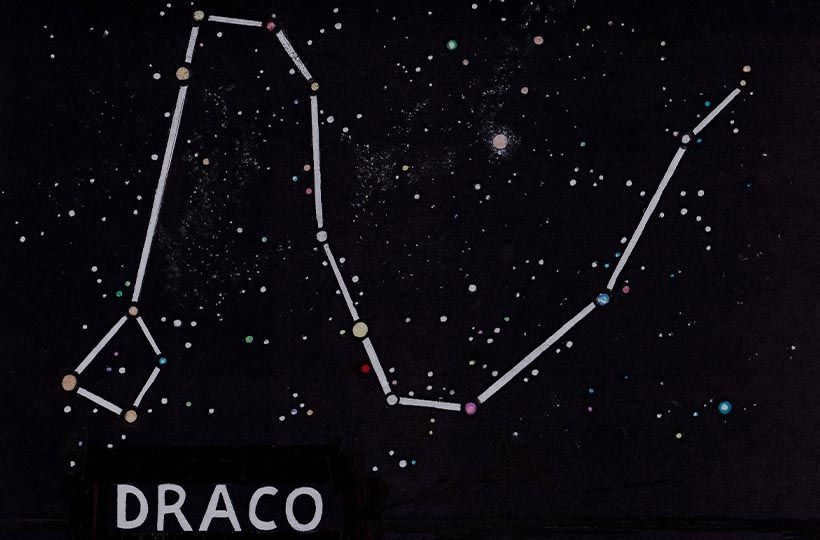
Hercules

Constellation Hercules
This group of stars is visible in the night sky in the northern region. It was named after Hercules, the legendary hero from ancient Greek mythology (known as Heracles in Roman mythology). In other cultures, it has been associated with Gilgamesh, the hero from Sumerian mythology. Despite being the fifth largest star cluster in terms of size, it does not contain any first magnitude stars. When depicted, Hercules is shown standing triumphantly over a defeated dragon. The star Ras Algeti represents the hero’s head, while the asterism Cornerstone represents his torso. One of Hercules’ most famous feats, slaying the dragon that guarded the garden of Hesperides, is depicted in mythology. Ptolemy added this constellation to the list in the 2nd century. It is home to several notable celestial objects, including the globular cluster Messier 92, the globular cluster Messier 1, the Hercules cluster of galaxies, the planetary nebulae Abell 39 NGC 6210, and the galaxy cluster Abell 2199.
This group of stars (known as normas in Latin) can be observed in the southern part of the sky, positioned between the constellations of Centaurus and Scorpius. The term “naugolnik” specifically refers to a tool utilized by both draftsmen and carpenters. This particular constellation was officially recognized in the mid-18th century by Nicolas Louis de Lacaille and was given the name l’Equerreetla Regle, representing the complete set of tools used by a draftsman. In terms of size, this constellation is one of the smallest and does not contain any particularly notable stars. However, it does include various interesting celestial objects such as the Fine-Ring Nebula, the bipolar nebula Mz 3, and the open clusters NGC 6067 and NGC 6087.
Serpentine
The summer constellation known as “Serpentine” derives its name from the Greek words meaning “bearer of the serpent”. It is located near the celestial equator in the southern part of the sky. Serpentine was first documented in the 2nd century by Ptolemy and is associated with Asclepius, a renowned healer from ancient Greek mythology. In Latin, the constellation is referred to as Serpentarius and is represented as a man holding a serpent.
This group of stars forms the head and tail of a snake, which coils around the waist of Serpentor. Despite crossing the ecliptic, there is ongoing debate as to whether Serpentine should be included among the zodiacal constellations, as it is also part of the Hercules group.
Some of the notable features of Scorpius include Barnard’s Star, Ras Alhage, Kepler’s Supernova, Barnard 68 dark nebula, NGC 669 nebula, M2-9, Dark Horse nebula, Snake nebula, Trumpet nebula, and globular clusters M9, M10, M12, M14, M19, M62, and M107.
Scorpius
This constellation, which belongs to the zodiacal group, can be found in the southern part of the sky and represents the scorpion. Ptolemy recorded it in the II century, but mentions of this constellation can be found in Babylonian history dating back 5000 years before the Greeks. This cluster of stars was known as GIR-TAB. It is quite easy to locate since the constellation is situated near the center of the Milky Way.
Reptile
This Hellenic star pattern (known as Serpens in Latin) is located in the northern part of the celestial sphere. Ptolemy first identified it in the 2nd century. It is composed of two sections: the top part (referred to as Serpens Caput) and the bottom part (called Serpens Cauda). Additionally, this constellation is home to numerous Messier objects as well as other captivating celestial entities.
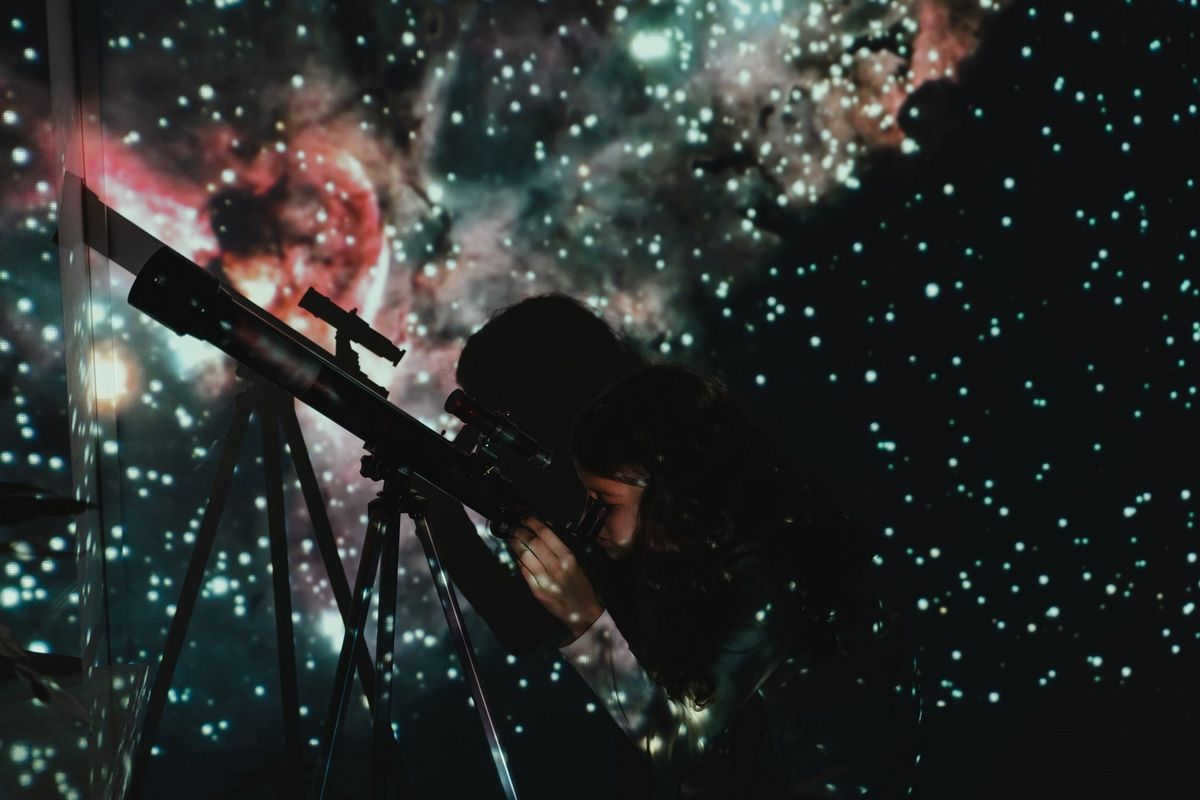
The Constellation Triangulum Australe
Triangulum Australe, also known as the Southern Triangle, is a constellation located in the southern hemisphere. It consists of three bright stars and was first documented by Peter Planucius in the 16th century. Later, in 1603, it was included in Johann Bayer’s Uranometria. While this constellation cannot be seen in Europe and most of the northern hemisphere due to its southern location, it is constantly visible from the southern hemisphere and the equator.
Southern Corona
Corona Australis, also known as the Southern Corona, is a constellation that occupies a relatively small region of the sky and is situated between Scorpio and Sagittarius in the southern hemisphere. This constellation represents the crown that was once worn by Sagittarius, the centaur. Unlike its counterpart in the northern hemisphere, the Southern Corona does not have any significant mythological associations. Its existence was first documented by Ptolemy in the 2nd century AD, alongside the Northern Crown.
The Lyra Constellation
Situated in the northern sky, the Lyra constellation is a famous summer constellation that represents the lyre, a well-known instrument from ancient times. This constellation holds a significant place in history as it is associated with the legendary poet Orpheus. It was officially recognized as a constellation by Ptolemy in the 2nd century. Notably, the Lyra constellation is home to the star Vega, which is ranked as the 5th brightest star, and the variable star RR Lyra. Additionally, this cluster of stars also contains the planetary nebula Messier 57, commonly known as the Ring Nebula, the globular cluster Messier 56, the open cluster NGC 6791, and the triplet galaxy merger NGC 6745.
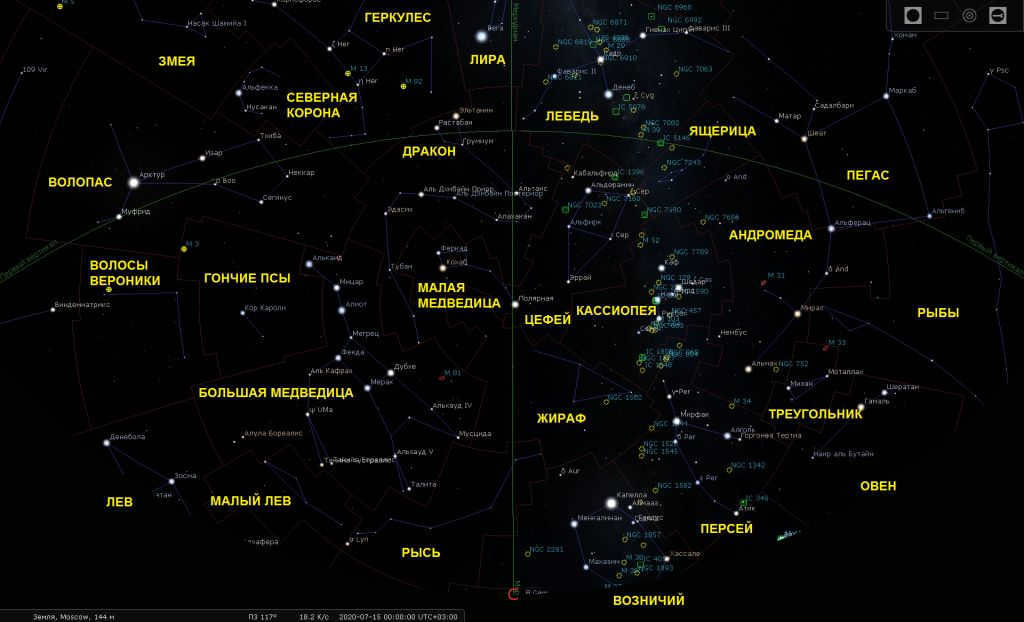
Sagittarius
The constellation Sagittarius is positioned in the southern part of the sky and is characterized by its depiction as an archer, often portrayed as a centaur with a bow and arrow. Within the zodiacal group, Sagittarius holds a significant place. In ancient mythology, it is closely linked with the satyr Krotus, who was responsible for guarding the Muses on Mount Helicon. Renowned for its grandeur, Sagittarius is one of the largest star clusters visible in the southern sky and was first documented by Ptolemy in the 2nd century. Its location on the Milky Way makes it easily identifiable, with its brightest stars forming the distinctive Kettle asterism.
The Shield
In Latin, the constellation known as Scutum translates to “shield.” It is situated in the southern region of the sky and ranks as the fifth smallest constellation. Discovered by Jan Hevelius in the 17th century, it was originally named Scutum Sobiescianum (Sobieski’s Shield) in tribute to King Jan III Sobieski of Poland, who famously triumphed in the Battle of Vienna in 1683. Following this historic event, a constellation emerged and was recorded by Hevelius. Over time, the name was shortened to simply “Shield.”
Optical Instrument
The star pattern, situated in the southern part of the celestial sphere, showcases the optical instrument known as a telescope. Nicolas Louis de Lacaulle, being fond of naming star clusters after inventions, bestowed this particular name upon it. Due to the inclusion of stars with a brightness of less than fourth magnitude, it appears rather dim. Although there are not numerous captivating celestial objects within it, the Telescope group, consisting of 12 galaxies, is present.

Constellations in the Summer Triangle
During the summer season, our attention is drawn to three bright stars that come together to form the “summer triangle” in the night sky. These stars are Vega (α Lyra), Deneb (α Swan), and Altair (α Eagle). For those located in the northern hemisphere, this formation serves as a prominent symbol of this particular time of year.
Close to the blue-hued Vega, we can observe the constellation Lyra, which appears as a small parallelogram, but only under conditions of sufficiently dark skies. It resembles a musical instrument played by Orpheus, whose enchanting music captivated all, including the denizens of the underworld.
If you observe the constellation Cygnus, it bears a resemblance to a cross, although with an imaginative perspective, one can easily perceive the likeness of a bird. In ancient mythology, it is Zeus who transforms into a swan in order to rendezvous with Leda, who later becomes the mother of Pollux and Castor. The swan metamorphosis is a necessary disguise to conceal this affair from Zeus’s lawful wife Hera.
Altair serves as the alpha star of the constellation Aquila, positioned as the third brightest luminary within the “summer triangle”. The configuration of this constellation possesses a notable and memorable structure. In the realm of mythology, it recounts the tale of the eagle that tormented Prometheus for ten millennia, relentlessly pecking at his liver as retribution for bestowing fire upon humanity. The gods sentenced Prometheus to be bound to a rock, where he would be subjected to the unforgiving torment of an eagle tearing at his flesh.
Searching for the summer constellations: a beginner’s guide
Located on the right side of Lyra, you will find the constellation Hercules. This heroic figure is famous for completing 12 incredible tasks. In the night sky, you can spot Hercules using one hand to strangle the Hydra, another constellation. Interestingly, the hero is depicted upside down.
Just below Hercules, you can observe the Serpent and the Serpent. Unlike other constellations, there are no specific legends associated with this one. It simply depicts a man holding a snake.
Not too far away, you will come across the Northern Crown, a stunning semicircle of stars led by Gemma. According to ancient mythology, this constellation was formed from the precious stones of a wreath, thrown by the god Bacchus to Ariadne. Ariadne was abandoned and suffering on the seashore, but the Northern Crown became a symbol of her resilience and strength.
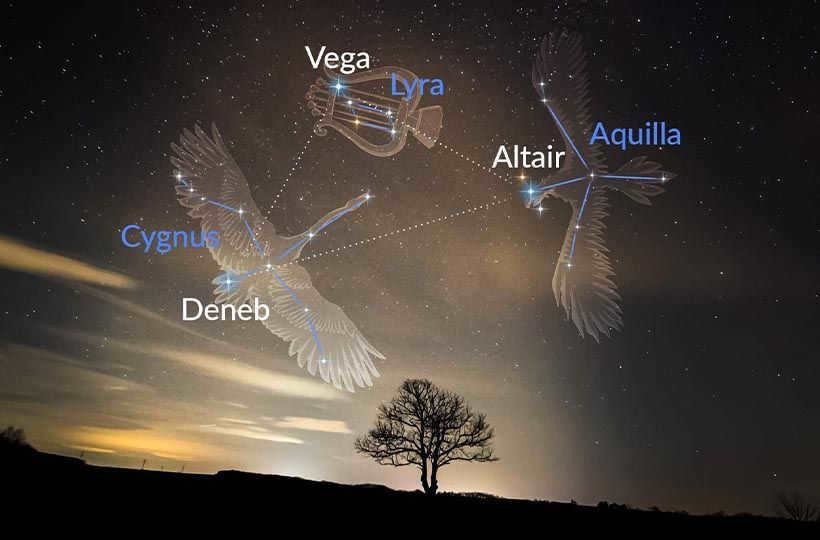

Not too far from the southern horizon, you can find the constellations Aquarius, Scorpio, and Capricorn. It’s quite easy to distinguish the star Alpha Scorpio from others due to its distinct red color. According to legend, Phaethon, who was riding a celestial chariot, had a fatal accident after being startled by a scorpion.
The constellation Sagittarius represents the centaur Chiron, a figure mentioned in numerous myths from ancient Greece. When observing Sagittarius, one’s gaze is directed towards the center of our galaxy. However, the powerful dust clouds make it impossible to see the nucleus, so radio telescopes are used to study it.
In addition to the previously mentioned notable constellations, there exist smaller constellations such as the Lesser Horse, Dolphin, Shield, Foxy, and Arrow. Out of these, the most prominent in the night sky is the Dolphin, as it creates a small rhombus connected to a chain of stars branching off from it, resembling the shape of a dolphin with a tail.
What could be more breathtaking than a sky filled with stars? Only a sky filled with stars, where you can locate the brightest star and differentiate a constellation from an asterism. Therefore, here are 10 interesting and informative facts about constellations.
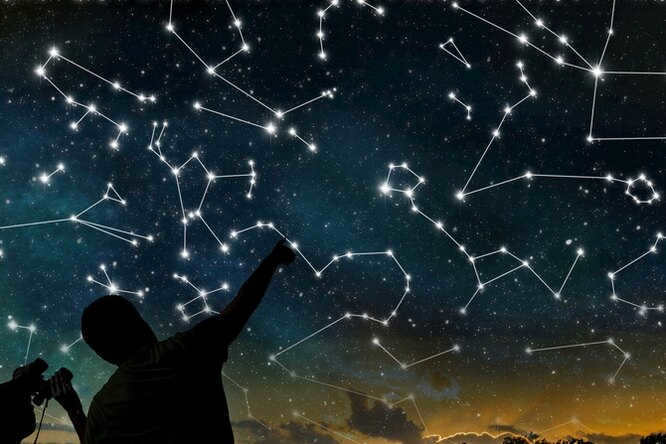
Constellations offer a wide array of fascinating details, and this article presents only those that most readers can easily observe with the naked eye.
For astronomy enthusiasts, interesting tidbits about constellations are like a treat from the diverse menu of this scientific field. And there is plenty to choose from, even when focusing solely on constellations.
Let’s delve into some fascinating information about constellations in the celestial sphere.
Constellations are divisions of the starry sky
Ancient civilizations devised a method to aid in celestial navigation by grouping stars into distinct patterns resembling various objects, mythological figures, and animals. This ingenious system allowed for the organization of the night sky, making each section easily identifiable. It simplified the study of celestial bodies, facilitated timekeeping, applied astronomical knowledge to agriculture, and provided a means of navigation using the stars. Interestingly, stars that appear to be in close proximity to each other in our sky can actually be incredibly distant from one another. Therefore, stars within the same constellation may bear no relation to each other and can exist at varying distances from Earth.
Typically, during our childhood, we acquire knowledge about constellations from encyclopedias and tales shared by adults. Those who develop a genuine interest in stargazing often adorn their walls with a celestial map.
There are precisely 88 recognized constellations.
The International Astronomical Union officially recognized 88 constellations in 1922, with 48 of them being documented by the ancient Greek astronomer Ptolemy in his star catalog “Almagest” around 150 BC. However, Ptolemy’s maps had gaps, particularly in the southern sky, which is understandable considering that the knowledge about constellations at that time only covered the part of the night sky visible from southern Europe. The gaps started to be filled during the era of great geographical discoveries. In the 14th century, Dutch scientists Gerard Mercator, Peter Keyser, and Frederick de Hautman added new constellations to the existing list, while Polish astronomer Jan Hevelius and Frenchman Nicola Louis de Lacaille completed Ptolemy’s work. In Russia, approximately 54 out of the 88 constellations can be observed.
There is a belief that our galaxy contains anywhere from 100 to 400 billion stars. It is conceivable that if even a fraction of them had the same brightness as Sirius, we would discover new constellations and acquire new knowledge about them.
Ancient cultures passed down their knowledge of constellations to us
Constellations offer a plethora of intriguing patterns and fascinating comparisons, despite their apparent limitations in terms of number and visibility.
The constellations we see vary depending on the time of year
One of the most logical yet astonishing facts about constellations is that they change throughout the year. As the Earth orbits the Sun, different parts of the sky and celestial bodies come into view. At night, we are able to see the constellations that are situated behind the Earth on our side of the Sun. During the day, however, the bright rays of the Sun prevent us from observing them.
Not long ago, I had a study session with my son. I grabbed his geography book and ended up getting lost in it for thirty minutes. The section about the night sky and constellations was particularly captivating. It brought back memories of facts I had long forgotten from my own school days. Suddenly, I felt a strong desire to gaze at the celestial luminaries through a telescope!
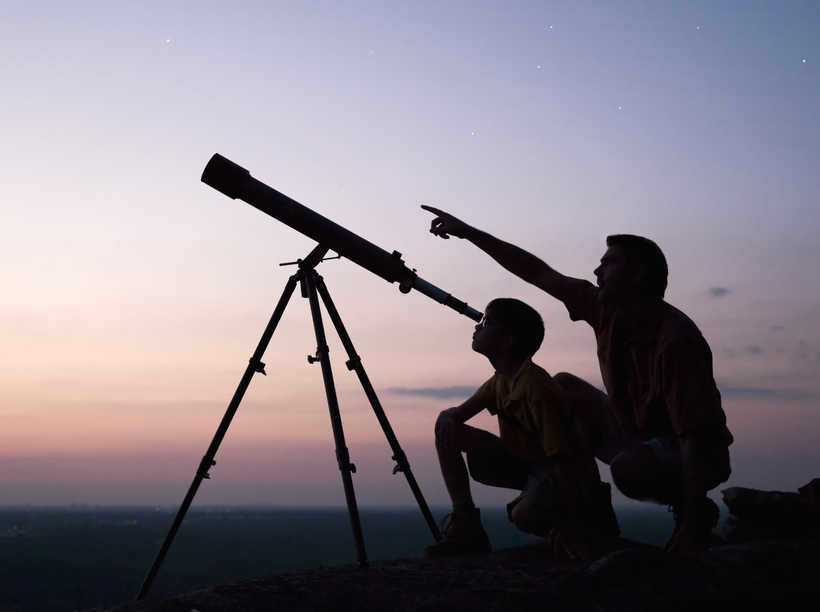
What are constellations composed of
At first glance, it may seem simple: constellations are made up of stars. However, this belief is incorrect. Or rather, it was incorrect in ancient times. Nowadays, constellations are defined as specific regions that divide the sky. Interestingly, the celestial boundaries are not arbitrary. Every astronomer knows precisely which part of the sky they are observing and what it is called. There are even star atlases available. Constellations are often named after the brightest star in that particular region. The stars themselves are designated by Greek letters (Alpha, Beta, Gamma, etc.).

Fascinating information regarding constellations
Undoubtedly, many individuals associate the celestial sky with an aura of enigma and incomprehensibility. I would like to impart some intriguing particulars concerning constellations:
- Presently, there are officially 88 constellations documented, but 47 of them were recognized prior to our era;
- The largest constellation, Hydra, encompasses 3.16% of the sky;
- The smallest constellation happens to be the Southern Cross, which consists of a mere 4 stars;
- The nearest constellation to the Sun, known as the Pleiades, is comprised of 3000 stars located 410 light years away;
- Proxima, the closest star to the Sun, is a constituent of the Centauri constellation;
- The most radiant star visible in the nocturnal sky is Sirius.
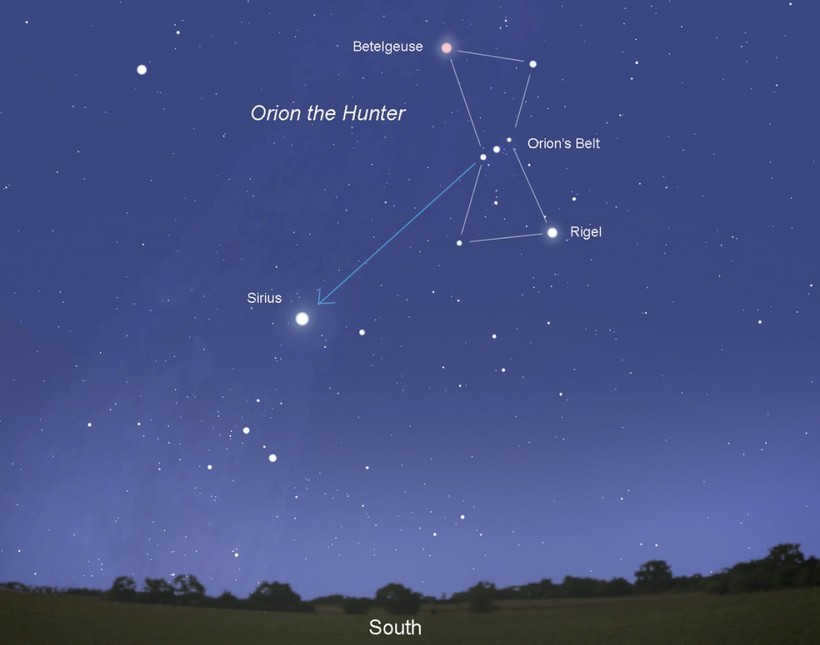
Zodiacal Cycle
The Sun completes a journey through 13 sectors along its celestial path each year, with each sector corresponding to a specific zodiac sign. While most people are familiar with twelve of these signs, the thirteenth sign – Serpentine – is not officially recognized among the zodiac constellations. It’s quite simple: the zodiac sign a person is born under is determined by the location of the Sun at the time of their birth. These constellations were first identified in ancient Greece and are now predominantly used in astrology rather than to represent the actual constellations themselves!
Personally, I have always found great joy in observing the stars through a telescope. I could spend hours gazing at the celestial sky, eagerly anticipating any unique celestial phenomena. Through my observations, I have become well-acquainted with the various constellations, their precise locations, and their fascinating histories. Today, I will share with you my knowledge of these awe-inspiring constellations.
What do constellations represent?
Constellations are groups of bright stars that have unique shapes when viewed from Earth. Although stars may be far apart from each other in reality, they appear close to each other in the night sky. By connecting the dots formed by the stars, we can create recognizable patterns, such as a cross. However, these patterns are not physically connected, and the stars within them may actually be at different distances from Earth. If we were to view the same stars from other planets, we would not see the same constellations. Different constellations are visible at different times of the year. Humans have given names to these constellations, often associating them with animals and objects in their surroundings. There are instances where two constellations share the same stars. In ancient times, people were familiar with fifty constellations, but by the nineteenth century, we had documented a total of eighty-eight constellations.
Unique Names of Constellations
The constellations have names that are connected to various elements:
- Real creatures: Cancer, Leo, Wolf, Hare, Scorpio
- Mythical creatures: Dragon, Hydra
- Heroes from myths: Perseus, Orion
- Simple objects: Southern Cross, Libra, Lyra
Throughout history, humanity has intertwined its story with the twelve constellations that the center of the Sun passes through during its yearly orbit: Aries, Taurus, Gemini, Cancer, Leo, Virgo, Libra, Scorpio, Sagittarius, Capricorn, Aquarius, and Pisces.





